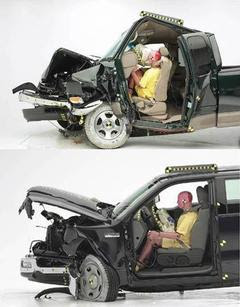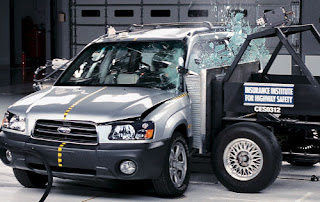If you’ve browsed through my posts, you probably saw an entry entitled “The Safest Cars of 2008”. As you may have guessed it’s a list of all the cars that came out this year that have aced safety standard tests, or if not, at least rated better than other vehicles. It’s a list put out by the Insurance Institute for Highway Safety or IIHS, which is an organization dedicated to reducing the number of deaths associated with car-related accidents. Before I only had an idea of how they did the tests because I once saw something like it being done on the Discovery channel, but today I ran across a post in SearchChicago – Autos, detailing how the tests are done. Kirk Bell, a contributor, wrote:
The IIHS advocates measures to avoid a crash, but accidents are inevitable, so the Institute conducts crash tests to evaluate front, side and rear crashworthiness. A vehicle can earn one of four ratings in each test: good, acceptable, marginal and poor.
Frontal Offset Test: The frontal test is a 40 mph offset crash with a dummy representing an average size adult male in the driver’s seat. Forty percent of the front of the vehicle strikes a barrier on the driver’s side. The barrier is made of aluminum honeycomb, and the IIHS says the forces in the test are similar to those in a crash between two vehicles of the same weight, each going about 40 mph.
The vehicle is evaluated based on measurements of intrusion into the occupant compartment, injury measures recorded on the dummy and slow-motion film analysis of how well the restraint system controlled dummy movement.
The dummy’s head, neck, chest, legs and feet are assessed for injury. The slow-motion film shows how well the seat belts, airbags, steering column, head restraints and other restraint features control dummy movement. Keeping the dummy from moving too much prevents another, interior collision or a partial or complete ejection from the vehicle. Intrusion on the safety cage is measured in 10 places in the driver seating area, and the front crush zone is evaluated for how well it managed the crash energy.
 Side Impact Test: The IIHS’s side crash test involves a vehicle with dummies in the driver’s seat and the rear seat behind the driver. The dummies represent fifth percentile females or 12-year-old children.
Side Impact Test: The IIHS’s side crash test involves a vehicle with dummies in the driver’s seat and the rear seat behind the driver. The dummies represent fifth percentile females or 12-year-old children.The vehicle tested is struck perpendicularly in the side by an SUV-height barrier that weighs 3,300 pounds moving 31 mph. The Institute’s ratings are based on injury measures recorded on the dummies, assessment of head protection countermeasures, and the vehicle’s structural performance during the impact.
The injury measures determine the likelihood that either occupant would sustain serious injury to the head, neck, chest, abdomen, pelvis or femur. How the dummies’ heads move and if they contact any surfaces are also evaluated. Structural performance is determined by how far the side pillar intrudes into the occupant compartment.

Rear Impact Test: The rear impact test measures the effectiveness of a vehicle’s seats. Rear crashes aren’t as likely to cause life-threatening injuries as front and side impacts. The main injury is whiplash, which can be prevented with a head restraint that stays close to the head.
The IIHS assigns a seat/head restraint geometry and a dynamic rating that combine for an overall rating. If the seat/head restraint geometry rates good or acceptable, the seat is subjected to a dynamic test. Seat/head restraints with marginal or poor geometry aren’t tested dynamically because they don’t protect taller people in rear-end crashes. These seats are given a poor overall rating.
For a seat/head restraint to receive a good or acceptable geometric rating, the IIHS says the head restraint should be no more than 9 centimeters (3.5 inches) below an average-size male’s head and sit back no more than 10 centimeters (4 inches).
For the dynamic test, a dummy with a realistic spine and neck is placed in the seat. All restraints are used and the seat/head restraint is bolted to a sled. The sled is shot forward, mimicking a stationary vehicle being struck from behind by a vehicle of the same weight doing about 20 mph.
This test assesses how well the seats support the torso, head and neck by measuring torso acceleration, the time for the head to contact the restraint and forces on the neck. Better seats allow the head to contact the restraint quicker and exhibit slower torso acceleration. Neck forces are classified as low, moderate and high. A seat must have low neck forces and either low torso acceleration or a quick time to head restraint contact to earn a good rating.
 Finally, the geometric and dynamic ratings are combined to determine and overall rating. It usually matches the dynamic rating.
Finally, the geometric and dynamic ratings are combined to determine and overall rating. It usually matches the dynamic rating.
0 comments:
Post a Comment